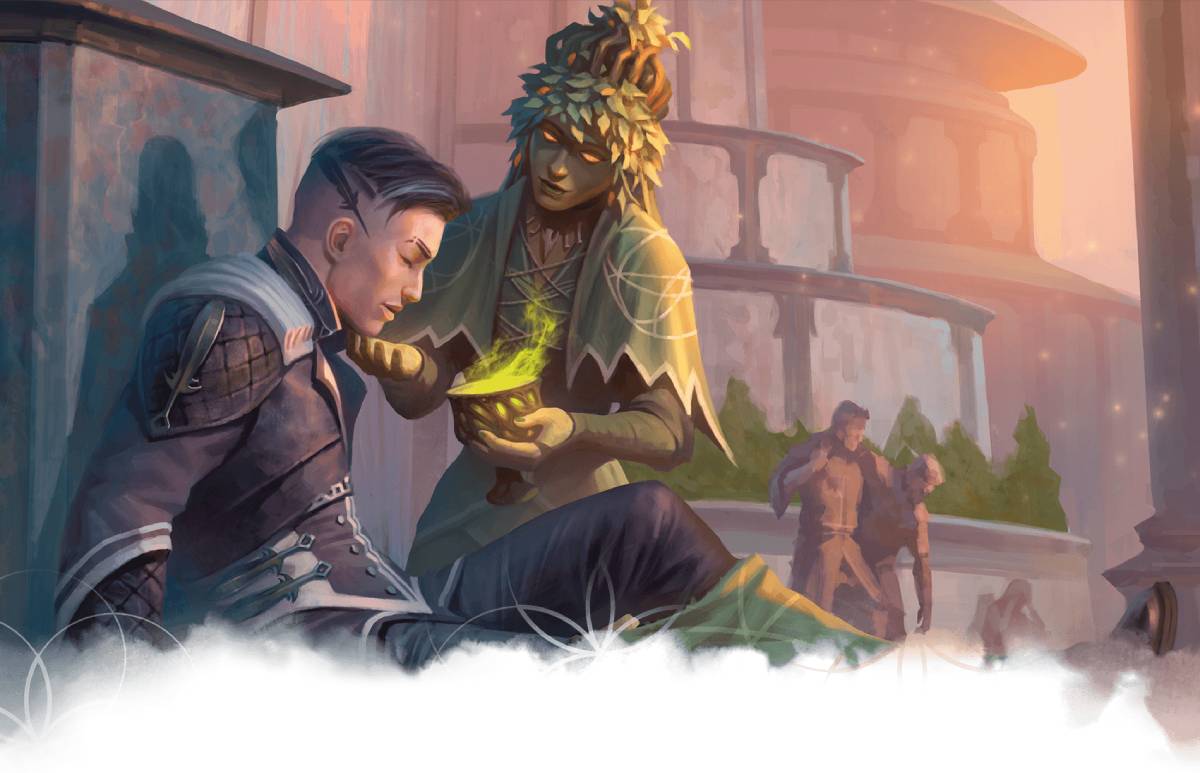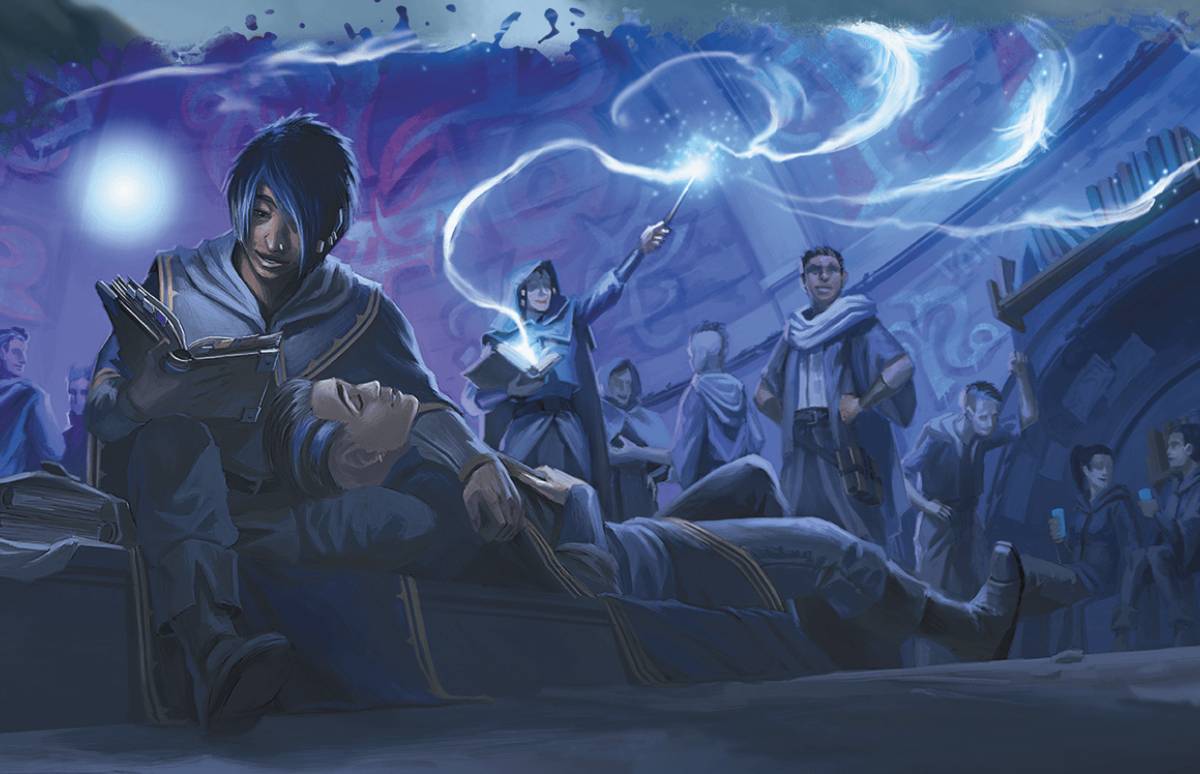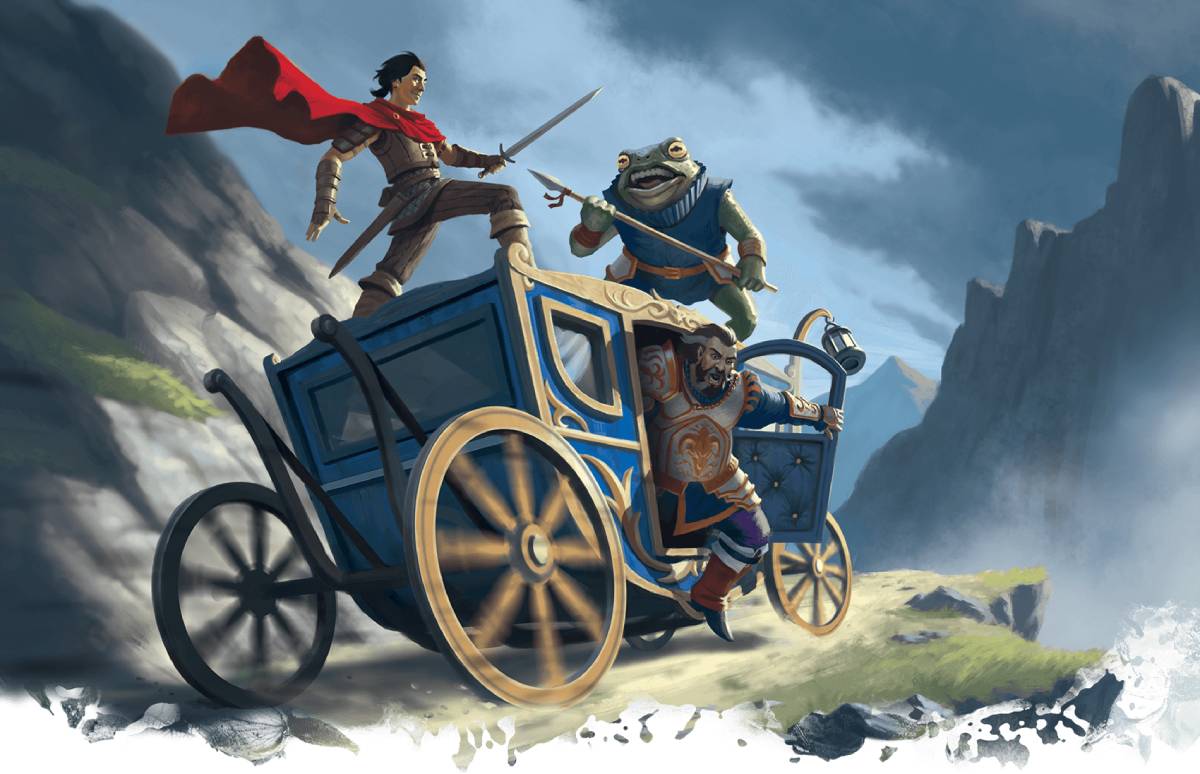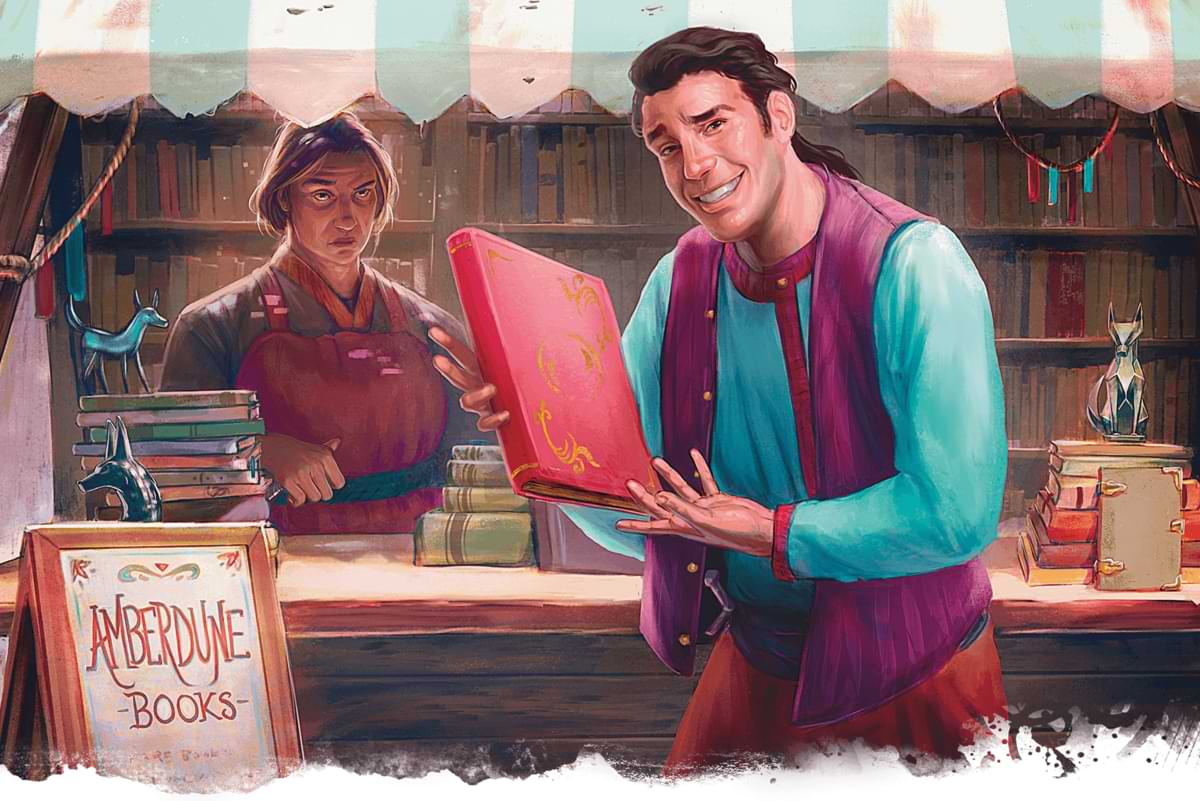One of the coolest parts about Dungeons & Dragons is how every table has their own rules. As a group, you may have spent countless hours embarking on unforgettable adventures, obtaining powerful relics, and exploring the backstories of your favorite characters. But, when it comes to starting your next adventure—whether it's a one-shot or a long-term campaign—you may want to switch up the game's core mechanics to introduce exciting new interpretations of D&D to your table.
There are a number of optional rules found in the Dungeon Master's Guide that are an excellent first step when searching for ways to switch up your D&D game. From varied healing mechanics to methods for dealing with massive damage, these optional rules can turn a high-fantasy system into a gritty, low-magic adventure. Or, you could embellish the "heroic" aspect of heroic fantasy and turn your game into an action-packed anime-style epic! In this article, we'll cover some of these options and provide insight into how they can be used to diversify your D&D game!
A Note On Optional Rules
Before modifying your campaign with these optional rules, it is best to discuss any ideas with your table. At its core, D&D is a collaborative experience, so make certain everyone approves of changes, big or small, that might impact their gameplay.
Healing

To begin, healing is integral to D&D since encountering powerful enemies sometimes results in terrible wounds. There are plenty of spells, potions, and class features that provide players with a way to bring their wounded party members back to fighting shape. Even slightly adjusting this core mechanic can dramatically alter the difficulty and tone of your adventures.
Here are a few alternative healing options from the Dungeon Master's Guide.
Healer's Kit Dependency
The only way characters can heal during a short rest is with a healer's kit, which will allow them to spend Hit Dice. Otherwise, they cannot naturally recover health, which will increase the significance of every point of damage the characters take. Players will have to be more cautious with their decisions in order to survive their next dungeon crawl.
Healing Surges
This optional rule allows characters to spend up to half of their Hit Dice in the middle of combat to heal. This provides a feeling similar to a superhero or anime hero epically recovering from a big blow. The added healing allows characters to engage in more deadly encounters. Instead of waiting until 20th level, a group of prepared characters could potentially go head-to-head with the strongest enemies the Monster Manual has to offer. Alternatively, you can have multi-staged boss battles that offer unique combat scenarios and create unforgettable plot points.
This optional rule is also handy in taking some pressure off the party cleric, who may want to do more than cast cure wounds.
Slow Natural Healing
On the opposite end of the spectrum, Slow Natural Healing takes away the character's ability to fully heal at the end of a long rest. Instead, they are forced to heal with their Hit Dice or any other method available to them. This will require serious resource management, which will add tension to sessions.
Rest Variants

Like healing, the short and long rest mechanics are tools players use to prepare for future encounters. Seasoned adventurers tend to plan when and where they can rest during a difficult adventure. This allows them to manage their resources and ensures they're ready to engage with their next terrifying foe. Implementing the rest variants from the Dungeon Master's Guide can turn the average moderately difficult campaign into a low-risk setting or even a setting where death might come from the next combat encounter.
Epic Heroism
This optional rule switches a short rest to 5 minutes and a long rest to 1 hour. This will alleviate wounds and restore spell slots far more quickly than an average campaign. Using this optional rule, Dungeon Masters can send wave after wave of enemies against the heroes, providing players the unique experience of being legendary warriors.
Gritty Realism
On the other hand, the Gritty Realism variant switches a short rest to 8 hours and a long rest to 7 days. This will increase the difficulty of a campaign since the players will have to seriously consider how to best spend their resources. This is a great option for groups who enjoy low magic settings.
Initiative

In combat, initiative determines the order in which the characters and enemies can act. A high initiative for your party means being able to deal damage or cast spells before enemies can even land a hit and vice versa. This can have serious implications for whichever side doesn't go first.
Speed Factor
In order to add some realism to your sessions, the optional Speed Factor rule offers various modifiers that you can apply to your character's initiative rolls (which happen each round rather than at the beginning of combat). These modifiers take into consideration several factors, such as weapon type as well as creature size. While this may take more time to determine, it can allow DMs to break from the predictable style of the typical initiative mechanics, which can be prone to metagaming. This initiative style is best for strategic, war-style games, where combat can take an entire session.
Speed Factor Initiative Modifiers
| Factor | Initiative Modifier |
| Spellcasting | Subtract the spell's level |
| Melee, heavy weapon | -2 |
| Melee, light or finesse weapon | +2 |
| Melee, two-handed weapon | -2 |
| Ranged, loading weapon | -5 |
| Creature Size | Initiative Modifier |
| Tiny | +5 |
| Small | +2 |
| Medium | +0 |
| Large | -2 |
| Huge | -5 |
| Gargantuan | -8 |
Damage

The danger of encountering powerful villains who wield powerful magic makes for memorable moments in D&D. To make every battle feel even more dangerous, the damage variant rules from the Dungeon Master's Guide can really up the ante. These options introduce the concept of long-lasting injuries and potentially lethal effects that might occur when a creature takes a tremendous amount of damage in a single hit.
Injuries
Usually, a character in D&D can be reduced to 1 hit point and be just as effective as if they were at full health. If your group is looking to add more realism to their campaign, this rule variant provides a list of injuries that can be obtained in the following ways:
- When a creature takes a critical hit.
- When a creature drops to 0 hit points but isn't killed outright.
- When a creature fails a death saving throw by 5 or more.
Once you have determined that a character has sustained an injury, the player can roll a 1d20 to see what kind of injury they receive and what the mechanical effect is.
Lingering Injuries
| d20 | Injury |
| 1 | Lose an Eye. You have disadvantage on Wisdom (Perception) checks that rely on sight and on ranged attack rolls. Magic such as the regenerate spell can restore the lost eye. If you have no eyes left after sustaining this injury, you're blinded. |
| 2 | Lose an Arm or a Hand. You can no longer hold anything with two hands, and you can hold only a single object at a time. Magic such as the regenerate spell can restore the lost appendage. |
| 3 | Lose a Foot or Leg. Your speed on foot is halved, and you must use a cane or crutch to move unless you have a peg leg or other prosthesis. You fall prone after using the Dash action. You have disadvantage on Dexterity checks made to balance. Magic such as the regenerate spell can restore the lost appendage. |
| 4 | Limp. Your speed on foot is reduced by 5 feet. You must make a DC 10 Dexterity saving throw after using the Dash action. If you fail the save, you fall prone. Magical healing removes the limp. |
| 5–7 | Internal Injury. Whenever you attempt an action in combat, you must make a DC 15 Constitution saving throw. On a failed save, you lose your action and can't use reactions until the start of your next turn. The injury heals if you receive magical healing or if you spend ten days doing nothing but resting. |
| 8–10 | Broken Ribs. This has the same effect as Internal Injury above, except that the save DC is 10. |
| 11–13 | Horrible Scar. You are disfigured to the extent that the wound can't be easily concealed. You have disadvantage on Charisma (Persuasion) checks and advantage on Charisma (Intimidation) checks. Magical healing of 6th level or higher, such as heal and regenerate, removes the scar. |
| 14–16 | Festering Wound. Your hit point maximum is reduced by 1 every 24 hours the wound persists. If your hit point maximum drops to 0, you die. The wound heals if you receive magical healing. Alternatively, someone can tend to the wound and make a DC 15 Wisdom (Medicine) check once every 24 hours. After ten successes, the wound heals. |
| 17–20 | Minor Scar. The scar doesn't have any adverse effect. Magical healing of 6th level or higher, such as heal and regenerate, removes the scar. |
Massive Damage
To make combat play out faster and more dangerous, this rule variant introduces the concept that when a character takes a great deal of damage, they suffer a devastating shock to their system. This triggers when a creature takes damage from a single source equal to or greater than half its hit point maximum. If they do not succeed on a DC 15 Constitution saving throw, they must determine the System Shock effect.
Although this might seem harsh, it could be beneficial to groups who wish to experience the threat of a one-hit kill. That said, it certainly works better for groups planning on starting at a higher level, as 1st-level characters would be susceptible to succumbing to these effects.
System Shock
| d10 | Effect |
| 1 | The creature drops to 0 hit points. |
| 2–3 | The creature drops to 0 hit points but is stable. |
| 4–5 | The creature is stunned until the end of its next turn. |
| 6–7 | The creature can't take reactions and has disadvantage on attack rolls and ability checks until the end of its next turn. |
| 8–10 | The creature can't take reactions until the end of its next turn. |
Plot Points

Even with an Oscar-worthy heartfelt speech, convincing a villain to turn away from the path of evil can be difficult, especially when you rolled low on your Persuasion check. This is where Plot Points shine as they offer players the power to influence the sessions in major and minor ways.
Using Plot Points
Each player starts with 1 plot point that they can then spend on one of the following options that will impact the story. This provides them additional agency to steer the campaign in a direction they would enjoy.
It is always beneficial to confirm with your group if the way you intend to use your plot point is acceptable. That way, it isn't used to undermine others at the table.
Option 1: What a Twist!
With this option, the player can summon a reasonable physical object or element that can assist the group in moving forward, such as a merchant selling the exact item the group needs or a distinct marking on a floor leading to a trap door.
Option 2: The Plot Thickens
This builds on our first option. When a player spends a plot point for an effect, the player to their right adds a complication. Perhaps you spend a plot point to have your bitter rival appear at the same tavern. The player to your right may determine that the rival is best friends with the tavern owner, and is therefore in a position of power.
Option 3: The Gods Must Be Crazy
This wild card of an option allows for swapping the Dungeon Master with another person. This will create sessions filled with unexpected results to the benefit or dismay of the group.
Time to Spice Things Up
Although we covered quite a few optional rules, the Dungeon Master's Guide offers many more rules variants. Be sure to crack open your own books or look them up on D&D Beyond to see what other aspects you'd like to add to your campaign!
DeAngelo Murillo (That_DeAngelo) is a fourth-generation Mexican-American who helps bring more representation to the geeky community through storytelling, journalism, interviewing creatives, and more on his Twitch channel. In his free time, he enjoys harassing his peers into participating in TTRPG charity events with him and also dies quite often in video games.








-
View User Profile
-
Send Message
Posted Apr 25, 2023I am required by law to make the following comment whenever this particular rule is brought up:
Gritty Realism is not for everyone. While yes it can solve some pacing issues and some tables will love it, it does not fix the system and can actually cause several problems for prep and balance that can be fixed but it's not a panacea.
Personally, the first time I used it was fun and worked for the campaign, but the campaign must support it. I've used it other times and it was a pain, slog, and made all of us miserable.
If anyone plans to use Gritty Realism, have a discussion in session zero and debate the merits. Be ready for some players to not be interested and even say they wouldn't want to play a Gritty Realism game.
-
View User Profile
-
Send Message
Posted Apr 25, 2023If there's the risk of the tank getting exhausted if they're knocked out, then it should also change the calculus of whether it's still more valuable to do damage and ignore healing them. The whole point of these rules is that the normal methods of playing would no longer apply.
-
View User Profile
-
Send Message
Posted Apr 25, 2023It won't though; it'll still better to bring down the enemy as fast as possible because healing is so much weaker than damage dealing in 5th edition.
Besides which the house-rule actually penalises you for bringing someone back during a fight, as if they've only got a handful of hit-points and go right back down again then that's yet another level of exhaustion. So you've actually made the "just leave them and hope we can end the fight before they die" scenario much more likely, which means either a player sitting out half a fight, or their character dying either because they were brought back (and gained too much exhaustion) or weren't brought back and failed too many death saves.
It's a house-rule that simply does not solve the problems that people claim to be trying to solve when they use it. Again, handing out injuries where it makes narrative sense is the better solution, because it gives consequences and stakes but doesn't have the flaws of a hard rule that can run into these kinds of issues.
-
View User Profile
-
Send Message
Posted Apr 25, 2023Tips like this are always valuable. Even for those that might have read the DMG and didn't get a grasp as to these options why they may/may not work for a group. Just love the highlighting of existing mechanics that often get looked over just because it's not openly used or in the PHB.
-
View User Profile
-
Send Message
Posted Apr 26, 2023I tend to agree. Here's the thing -- the DM probably shouldn't unilaterally decide to go for gritty realism unless the players are into it. If everyone is into it, gritty realism is not about punishing players, it's about ramping up the danger for the sake of having fun. If you are a player and you think the DM is punishing you, you need to have a sit-down. The game is supposed to be fun for everyone and you need to reach some agreement on what is and is not fun. If you are a DM and you think you are punishing your players, knock it off.
-
View User Profile
-
Send Message
Posted Apr 26, 2023Nice!
-
View User Profile
-
Send Message
Posted Apr 26, 2023this has really helped me thank you for making this post
-
View User Profile
-
Send Message
Posted Apr 26, 2023Lol
Most of the big names out there, spreading the good word of DND, haven't read the DMG or PHB.
The rules aren't the game. The map isn't the territory.
-
View User Profile
-
Send Message
Posted Apr 26, 2023The DMG isn't a book that you need to read in its entirety; even the people that have read literally all of it can't possibly remember everything in it, and half of it is optional rules anyway. You don't need to know anything about running the game on a hex grid (or even a square grid) if that's not how you run your games, just like you don't need to know the gritty realism rules variants if you're not going for gritty realism.
-
View User Profile
-
Send Message
Posted Apr 26, 2023Wow, look at all these things people on Reddit are mad that 5e doesn't have
-
View User Profile
-
Send Message
Posted Apr 26, 2023I always liked the idea of Healing and Rest Variants but I find players don't want that level of realism. Also, D&D Beyond currently does not allow the DM to set restrictions during character creation or during the game which makes it easier for players to use such rules. As such people default to what the system recommends. Until D&D Beyond allows DMs more control of character creation and game play these rules don't really work well.
I would love the first question in character creation to be, "Who is your DM" followed by, "What campaign are you playing in"? This would allow DMs to have a page set up with their preferences for the game.
-
View User Profile
-
Send Message
Posted Apr 26, 2023I have been running Gritty Realism for quite some time, my players where hesitant but I offset this by letting them concentrate on multiple spells at once, each spell increases the dc of the concentration check by the spells level, this seems to balance well.
-
View User Profile
-
Send Message
Posted Apr 26, 2023Cool
-
View User Profile
-
Send Message
Posted Apr 26, 2023Oooh, that is a good mechanic.
-
View User Profile
-
Send Message
Posted Apr 26, 2023To be honest, the only optional rule I sometimes use is the speed factor for initiative. It's a great optional rule because any round could have different turn orders which I think is rather fascinating despite the fact I play lots of RPG video games that use a similar battle play. It's also helpful to the players since the bigger someone's size is, the lower their initiative score is. So bigger doesn't always mean better...
-
View User Profile
-
Send Message
Posted Apr 28, 2023Fair enough. I am just a stickler for following RAW. Some people are going to prefer different levels of rule-following, it's an important part of play style that I think is often left out.
-
View User Profile
-
Send Message
Posted Apr 28, 2023Wow such good ideas. I'm sure DnDBeyond as a site covers all of them in the character sheets!
-
View User Profile
-
Send Message
Posted Apr 28, 2023The optional initiative system will become very complicated with all the weapon swapping that the newest UA's Weapon Mastery properties add in.
-
View User Profile
-
Send Message
Posted Apr 29, 2023I like having Sorcerers get their sorcery points, AND then Spell points optional rules in the DMG rather than Spell Slots to further emphasize the difference between them and Wizards mechanically.
Leastways, I sometimes do that, but DnD Beyond not supporting Spell Points optional rules has actually made that difficult for players who use this platform. I get they don't need to support every optional rule, this is just one that I wish was available, because it would really help my personal play style.
-
View User Profile
-
Send Message
Posted Apr 29, 2023Healer kits # A player will end up wanting to buy 30 healer kits to put in his backpack at the next village and ask why he cant find some more...
Healing Surge # Players are already over CR in D&D5e that I have to put the monsters at Full Max life and double them up in numbers...
Natural Healing # We implemented that one at the start of our campaign where how player rest they would receive healing following the life style level of the rest. Sleep outside no roof no camp setup = no healing "VS" Sleep at the Inn within the most comfy room = full rest healing. The roleplay gets better and players have a real reason to carry adventurers gear like tents, bedroll and blankets, etc...
What D&D Beyond need its # drop down menu on the rest/full rest button with a choice of lifestyle rest (0/5 no hp gain to 5/5 full healing).